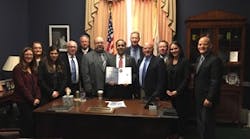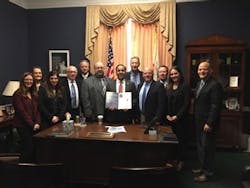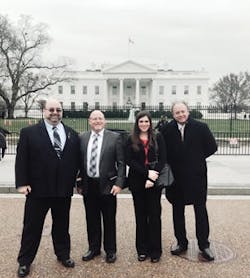In February, the Society for Maintenance & Reliability Professionals (SMRP) held its fourth annual Capitol Hill fly-in, drawing national leaders in maintenance, reliability, and physical asset management to Washington, DC. SMRP Executive Director Erin Erickson spoke with Plant Services recently about her impressions as a member of the 2018 fly-in team.
PS: What goals did SMRP have in mind heading into this year’s meetings, and do you think you achieved them?
EE: SMRP views the fly-in as an opportunity to promote the organization and our members as subject-matter experts who are willing to serve as a resource for any bills or legislation that are coming out. We typically advocate for our four key priorities: workplace safety, cybersecurity and critical infrastructure, (the) smart grid, and workforce development. The fly-in lasts a day, and it’s a pretty organized format. We do the legislative meeting over the course of about seven hours. Everyone participating does an intro meeting in the morning and then we leave for the Hill. This year we met with over 11 offices within the House of Representatives and the U.S. Senate and we stayed an extra day and met with the White House Education Advisory Team.
SMRP participated in a Career and Technical Education (CTE) Caucus briefing that provided insight into the skills gap issue taking place within the maintenance and reliability profession. It was, by far, the most successful fly-in to date.
PS: What were your impressions of the CTE briefing? How did it go, and what was the format?
EE: The CTE briefing was successful. I represented SMRP on the panel. It was a coordinated effort with the National Skills Coalition, Advance CTE, the American Institute of Research, and NACE International. In addition to NACE International, SMRP provided more of the industry representation, whereas National Skills Coalition and Advance CTE were speaking more from the federal and state policy side of things.
The interaction between panelists became pretty collaborative. We had about 50 people present. The briefing focused on the Carl D. Perkins Career and Technical Education (CTE) Act. It was an opportunity for SMRP to advocate for the importance of workforce development and share SMRP member success stories.
I incorporated examples of SMRP’s executive member companies that are working with trade schools and community colleges at the local level to develop apprenticeship programs. Nissan North America, for instance, partners with the Tennessee College of Applied Technology and has developed a successful apprenticeship program. I also shared the success Wells Enterprises has experienced, along with four other businesses in Iowa. Together, they are partnering with Northwest Iowa Community College and building a curriculum around industrial maintenance topics.
Several individuals who have completed a CTE program and are earning higher salaries now as a result shared their personal success stories. We also talked quite a bit about how to generate interest at the high school level and how some of these manufacturing companies can partner with high school curriculum contacts to spread awareness.
PS: Did you note any specific Congressional leaders who were drawn into the conversation, or was it more of an across-the-board opportunity for those leaders present to ask you their own questions?
EE: Rep. Cheri Bustos from Illinois and Rep. Brian Babin from Texas were gracious and hosted the CTE briefing for us. Unfortunately, they couldn’t attend due to their voting schedule; however, representatives from their offices were there. As far as the fly-in, congressional and senate meetings are determined based on who resides in those particular states. Generally, there is a volunteer present who can help lead the conversation and answer questions. And because SMRP does have working groups that focus on the priorities being discussed, they’re passionate about these issues.
PS: Did you get a sense there was a receptive interest on the part of the congressional leaders in talking about the Perkins reauthorization bill?
EE: Yes. In fact, Rep. Raja Krishnamoorthi from Illinois recently wrote an article for the Jan.-Feb. 2018 issue of SMRP’s Solutions magazine that focuses on the Perkins reauthorization bill. It was the reauthorization of the bill that he, along with another congressman, developed. The bill was passed unanimously by the House. Right now, it is held up in the Senate HELP Committee.
PS: The White House briefing this year sounds like it was a different element from last year’s fly-in.
EE: It was new, yes, and very exciting. It’s difficult to get in at that level, but we have a pretty great DC team that was able to do it. SMRP previously submitted a letter to President Trump supporting the presidential executive order on expanding apprenticeships in America, so we followed up with the White House after submitting that letter and especially after the State of the Union address when the President reported that workforce development is a priority of his. A small group of SMRP leadership met with a representative from President Trump’s White House Education Advisory Team. We discussed workforce development and advocated for career technical education.
We ended up meeting with the White House representative for a full hour. It was very collaborative. We discussed some concerns regarding the skills gap as it relates to maintenance and reliability and then of course offered to be a resource to the White House to help them close the skills gap. We emphasized our support of the Strengthening Career and Technical Education for the 21st Century Act, which is the reauthorization of the Perkins bill. (Note: The bill summary is available at https://plnt.sv/1805-SMRP.)
PS: So many stories in the news this year – the FIU bridge collapse and cybersecurity vulnerabilities such as Spectre and Meltdown, for example – have aligned with SMRP’s priorities. What kind of impact do you think that this year’s fly-in had in those areas?
EE: All four subjects are interconnected. Cybersecurity and critical infrastructure really go hand-in-hand on a daily basis, and with all of the news and developments surrounding critical infrastructure, especially with the U.S. being a target by other countries like Russia, cybersecurity has been a hot topic. We promote that having safe infrastructure allows for a more secure and reliable infrastructure, and we will continue this discussion as technology and infrastructure evolves.




